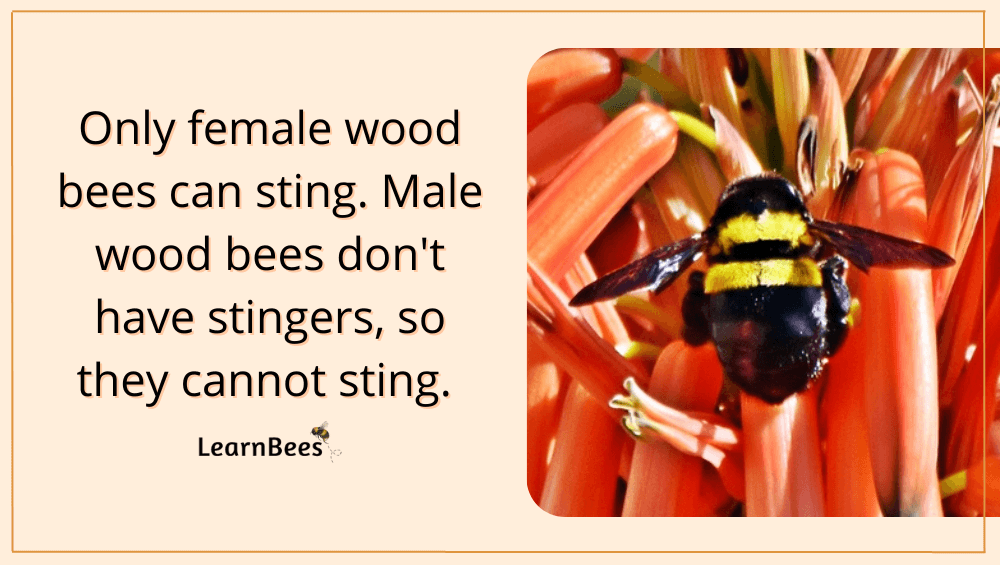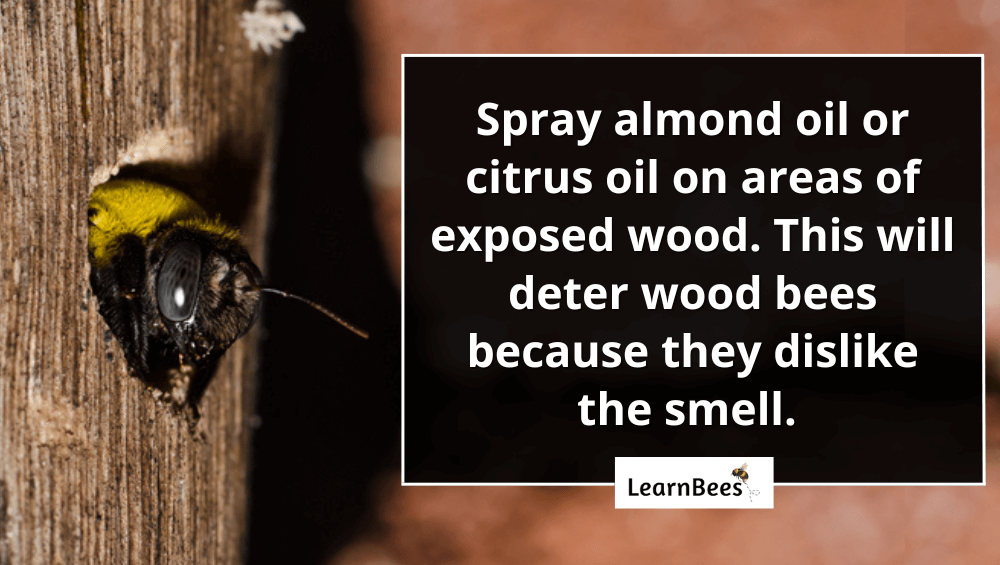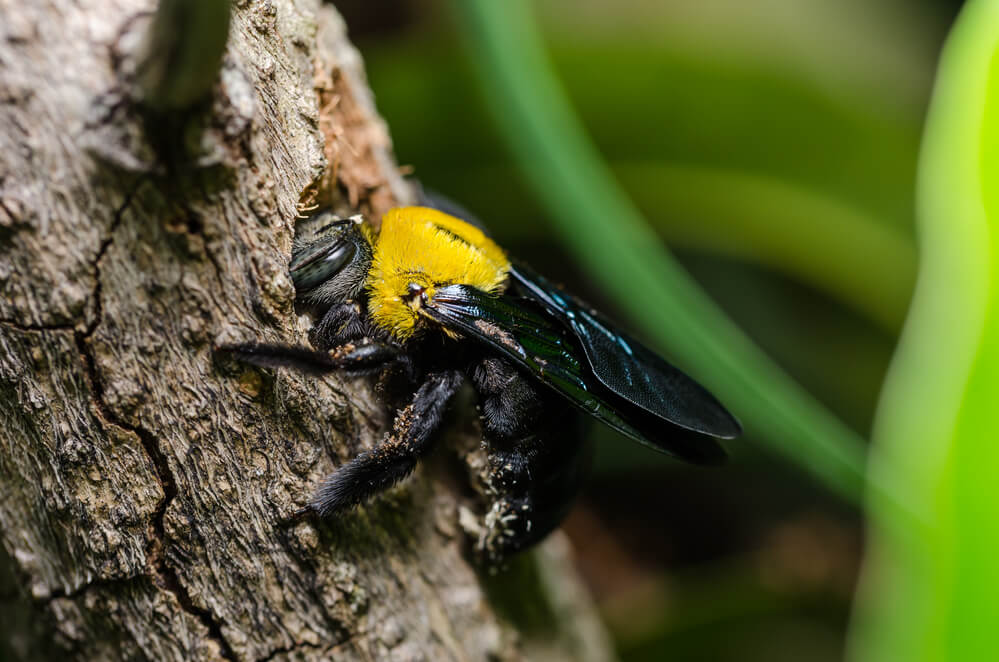Table of Contents:
Are Wood Bees Harmful?

No, wood bees aren’t harmful to people or pets. They’re large, gentle-natured bees that won’t go out of their way to sting you. As such, they’re nicknamed “gentle giants.”
But here’s the thing:
The name “wood bees” is a colloquial term for carpenter bees, a type of bee known for drilling holes in wood. They drill into wood to create their nests.
This means that wood bees (carpenter bees) can drill holes into wooden areas around your home, such as inside roof eaves or wooden siding.
But the good news?
Wood bees are easily deterred by spraying almond oil or citrus oil around exposed wood. You shouldn’t spray them with harsh chemicals or insecticides because they’re vital pollinators.
As mentioned, wood bees are gentle bees that rarely sting. They’re considered a keystone species, which means the ecosystem would be drastically different without their beneficial presence.
With that said:
Wood bees prefer unpainted, weathered wood, especially softer varieties such as cedar, redwood, pine, and cypress. Painted or pressure-treated wood is much less appealing to carpenter bees.
Do Wood Bees Sting?

Female wood bees can sting, but they rarely do. A wood bee’s natural response is to fly away at the signs of trouble instead of stinging.
More importantly?
Only female wood bees can sting. Male wood bees cannot. Stingers are modified egg-laying organs, so only female bees have them.
With that in mind, female wood bees spend most of their time collecting food and tending to their baby bees. In other words, most people rarely encounter female wood bees because they’re busy nesting.
But male wood bees, on the other hand?
Those are the type of carpenter bees that most people see. The males typically hover outside the nest to patrol the area. Despite being unable to sting, the male wood bees will “put on a show” and buzz around potential intruders to scare them off.
Meanwhile, the female wood bee is typically inside the drilled hole, tending to her baby bees.
How Do I Get Rid of Wood Bees?

If you want the best shot at deterring wood bees without harming these precious pollinators, follow these two steps:
Step 1: Spray Almond Oil or Citrus Oil on Exposed Wood
For the citrus oil method, begin by pouring citrus oil into an empty spray bottle. You can combine it with water, but we don’t recommend overdiluting it. You want the citrus oil to maintain its strong odor.
Next, spray the citrus oil liberally around areas of exposed wood. Additionally, spray around the holes where the wood bees have drilled.
Note:
Don’t spray anything inside their holes because you don’t want to hurt them – only deter them. Just spray along areas of exposed wood.
You can also make your own citrus oil spray by boiling orange peels for a few hours. Make sure you boil plenty of peels in the water to get the citrus scent potent.
The almond oil spray works similarly to the citrus oil spray, except you may find it easier to “paint” the almond oil on exposed wood instead of spraying it. However, almond oil can also be sprayed depending on whatever you find easiest.
But we recommend testing a small patch of almond oil on the area first because it’s been known to stain certain types of wood.
Now don’t forget:
Don’t assume that any type of oil will work to repel wood bees. Use almond oil or citrus oil only.
For instance, using olive oil, vegetable oil, or canola oil will be pointless. Those oils don’t deter wood bees like almond or citrus oil does.
Step 2: Hang a “Bee Hotel ” Closeby
Confession time:
Several years ago, I moved into a log cabin made from aged cypress wood. I loved it. And as it turns out, the wood bees did too.
Once springtime came, I realized I had three or four wood bees drilling holes into my cabin. I sprayed citrus oil on the outside and hung a bee hotel near the garden. The wood bees were deterred by the citrus oil and moved into the bee hotel I provided.
So, in summary:
- Spray exposed wood with citrus oil or almond oil
- Hang a “bee hotel” nearby
FAQs on Wood Bees
- Can wood bees destroy your house?
- Are wood bees good to have around?
- Should I remove wood bees?
- Should I leave wood bees alone?
- What attracts wood-boring bees?
- How long do wood bees stay around?
- Do wood bees remember you?
- What are wood bees afraid of?
- What smell do wood bees hate?
- What kills wood bees on contact?
- What happens if you plug up wood bee holes?
- How do I get rid of wood bees?
Can wood bees destroy your house?
No, carpenter bees (aka wood bees) will not cause structural damage to your home. Wood bees only drill holes one to two inches deep, which isn’t deep enough to cause significant damage.
With that said, multiple holes can make your home look unsightly. That’s why it’s wise to use citrus or almond oil on areas of exposed wood. Spray one of these oils in the early spring before the wood bees emerge and nest.
From there, fill any old holes from previous wood bee nests. This will discourage wood bees from nesting in old holes from earlier years.
You can also try putting up a bee hotel. This is a structure that provides wood bees with a nesting place. Once they have a place to nest, they’ll be less likely to bore holes into your home.
—> Go back to the FAQs on wood bees
More to Explore:
Are wood bees good to have around?
Wood bees are excellent pollinators and are actually quite docile creatures. They’re not aggressive and won’t sting you unless you somehow swat at them or provoke them.
In fact, bees are known as “keystone species.” A keystone species is an animal that plays a key role in maintaining the health of an ecosystem.
For example, bees pollinate flowers and crops. This helps to ensure that plants can reproduce and continue to grow. Pollination also helps to ensure that there is a food supply for humans and animals.
Bees are responsible for pollinating about one-third of the food we eat. So, without bees, we wouldn’t have many of the foods we enjoy today.
With that said, wood bees can be a nuisance if they keep drilling holes in your home. If you want to get rid of them, follow the steps above.
—> Go back to the FAQs on wood bees
More to Explore:
Should I remove wood bees?
It’s not necessary to remove wood bees unless they’re causing damage to your home.
If you want to get rid of them, the best way is to use citrus oil or almond oil on areas of exposed wood. You can also try hanging a bee hotel nearby to give them an easy relocation place.
However, if the wood bees aren’t bothering you, it’s best to leave them alone. These friendly bees help pollinate plants and flowers, which is key to maintaining a healthy ecosystem. Additionally, wood bees are known for their mild nature. They don’t actively seek out trouble and very rarely sting people or pets.
—> Go back to the FAQs on wood bees
More to Explore:
Should I leave wood bees alone?
Yes, you should leave wood bees alone unless they’re causing damage to your home.
These helpful insects play an important role in pollinating plants and flowers. This helps to ensure that there is a food supply for humans and animals.
Additionally, wood bees are relatively docile creatures. They’re not aggressive and won’t sting you unless you somehow swat at them or provoke them. So, there’s no need to kill them or remove them from your property unless they’re drilling holes into your home or wooden structures.
—> Go back to the FAQs on wood bees
More to Explore:
What attracts wood-boring bees?
Wood bees are attracted to two things:
- Wood
- Flowers
As their name implies, wood bees drill holes into wood to create their nests. This can include the wood on your home, outdoor furniture, or random trees around your property.
Wood bees also like flowers because they rely on them for food. If you’ve ever looked around a flower garden, you’ll notice many species of bees, including honeybees, bumblebees, and wood bees.
These busy bees are focused on collecting nectar and pollen from the blossoms. They take it back to their nests to feed themselves and the baby bees. In turn, they help pollinate the plants and food crops around us.
This is why wood bees – and other bee species – are considered crucial pollinators. They help us in more ways than we can imagine, including helping to provide many of the fruits and vegetables we humans rely on.
So, if you’re wondering what attracts wood bees, the answer is simple: they’re attracted to wood and flowers.
—> Go back to the FAQs on wood bees
More to Explore:
How long do wood bees stay around? How long do wood bees last?
The lifespan of a wood bee varies depending on the species. Some species only live for a few months, while others can live for up to one year or longer. There are hundreds of different carpenter bee (wood bee) species around the globe.
With that in mind, wood bees are warm-weathered creatures that thrive in spring and summer. They’re most active during the day, specifically around dawn and dusk.
You’ll likely see them flying around your property or garden for wood or flowers. Once they find a suitable spot, they’ll drill a hole and create their nests.
Once the wood bees lay their eggs, the baby bees will hatch and start the cycle all over again. This cycle can repeat itself multiple times throughout the year, which is why you might see wood bees on your property even if you only noticed them for the first time recently.
But once winter hits, the female wood bees go into hibernation, and you won’t see them again until the spring.
—> Go back to the FAQs on wood bees
More to Explore:
Do wood bees remember you?
Yes, some research suggests that bees can remember human faces.
—> Go back to the FAQs on wood bees
More to Explore:
What are wood bees afraid of?
Wood bees are repelled by citrus oil and almond oil. But we can’t say they’re “afraid” of these oils. Additionally, we don’t understand how bees and other insects perceive fear, so it’s a tricky question to answer.
—> Go back to the FAQs on wood bees
More to Explore:
- Ground Bees: Are They a Threat to Your Yard?
- Wasps vs. Honeybees: Are They Different?
- Do Bumble Bees Bite?
What smell do wood bees hate?
Wood bees hate the smell of citrus oil and almond oil. If you have a wood bee problem on your property, you can try using one of these oils to repel them.
—> Go back to the FAQs on wood bees
More to Explore:
What kills wood bees on contact?
We do not recommend killing wood bees because they’re essential pollinators that help humans and other animals. Instead, you can deter them naturally by using essential oils like citrus oil and almond oil.
You can also try to block their access to their old nesting sites by sealing up any holes or cracks in your home. And if you have any wooden furniture or structures on your property, seal holes in them.
Taking these preventive measures can help keep wood bees away from your home without killing them.
—> Go back to the FAQs on wood bees
More to Explore:
- Do Carpenter Bees Pollinate?
- How Long Do Bumble Bees Live?
- Honeybees vs. Bumblebees: How Do They Compare?
What happens if you plug up wood bee holes?
Plugging up old wood bee holes is good as long as the bees aren’t nesting inside them. You don’t want to plug the holes while the wood bees are inside of them because you may kill them.
Instead, wait until the wood bees have vacated the area before you plug the holes. Once they’re gone, you can use caulk or another sealant to fill in the holes and prevent them from returning.
—> Go back to the FAQs on wood bees
More to Explore:
- What is Bees Bread?
- Are Worker Bees Male or Female?
- Queen Bee Versus Worker Bees – How Do They Compare?
How do I get rid of wood bees?
People often ask:
What is the fastest way to get rid of wood bees? How do you keep wood-boring bees away?
The best way to get rid of wood bees is to prevent them from nesting on your property in the first place. You can do this by sealing up any holes or cracks in your home and any wooden furniture or structures on your property.
You should also avoid using pesticides, which can kill beneficial insects like bees. If you have a wood bee problem, you can use oils like citrus and almond oil to repel them.





